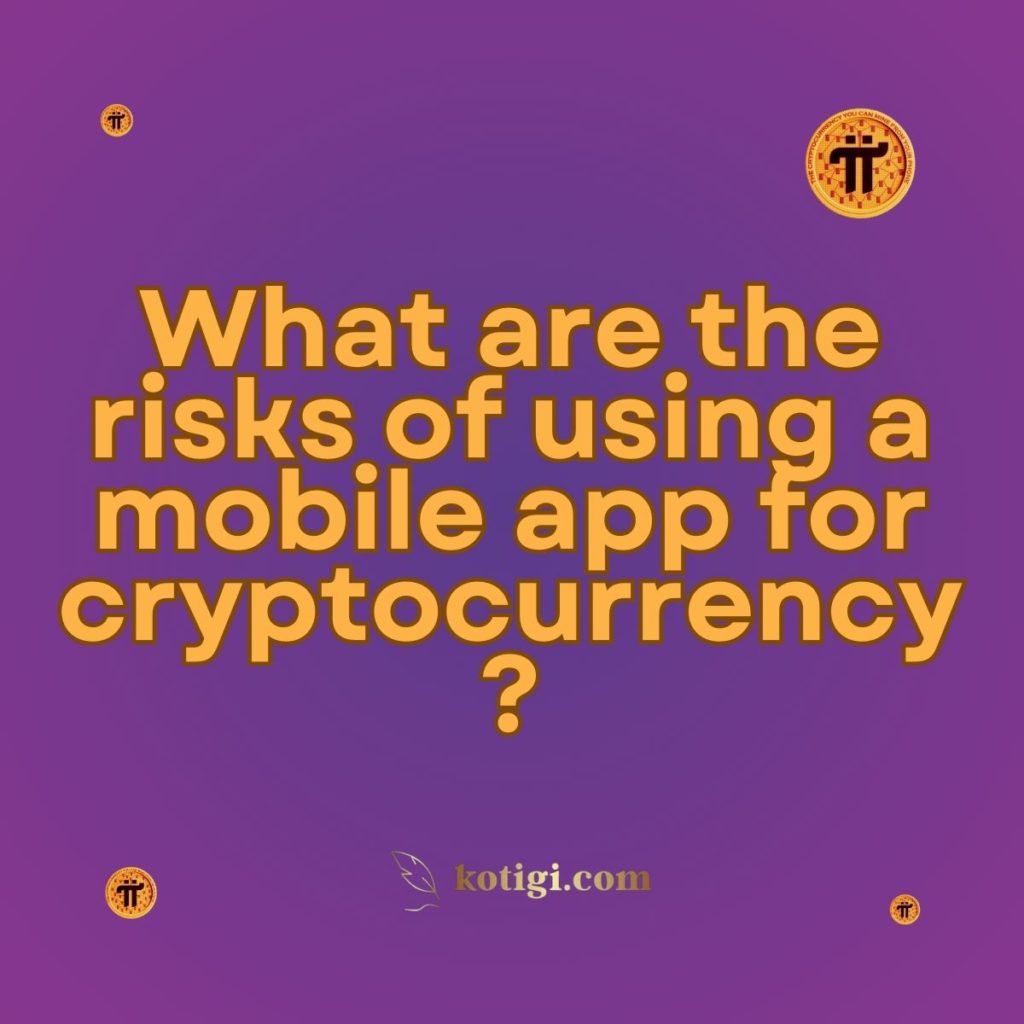
What are the risks of using a mobile app for cryptocurrency?
Using mobile apps for cryptocurrency brings various risks, including security vulnerabilities, malware threats, loss of private keys, and potential data breaches. While mobile apps offer convenience, users must remain cautious to ensure their assets and personal information are protected.
Introduction
Cryptocurrency has become increasingly accessible thanks to mobile apps, which allow users to manage, trade, and store digital assets right from their smartphones. These apps have made entering the crypto world easier, offering convenience at users’ fingertips. However, like any technology, mobile apps come with their own set of risks. From security vulnerabilities to user inexperience, the risks can lead to financial losses, privacy breaches, and even the complete loss of your digital assets.
Understanding the potential dangers of using cryptocurrency mobile apps and implementing safety measures can help users protect their investments. This guide delves into the specific risks associated with mobile apps and provides suggestions on how to mitigate them.
Security Vulnerabilities in Mobile Apps
Security is a top concern when dealing with cryptocurrency, and mobile apps are often seen as more vulnerable than hardware wallets or cold storage options. Mobile devices are constantly connected to the internet, making them potential targets for hackers. The apps used to manage cryptocurrency can contain weak points that attackers exploit to gain unauthorized access to users’ funds and data.
Lack of End-to-End Encryption
Many mobile cryptocurrency apps fail to employ strong encryption methods, leaving communications between the app and the server vulnerable to interception. Without proper encryption, sensitive data, including login credentials and transaction details, can be intercepted by cybercriminals during transmission. This opens the door for man-in-the-middle attacks, where hackers can pose as the server or the user to steal sensitive information.
Outdated Software
Another risk stems from outdated app versions. Mobile apps that are not regularly updated may contain security vulnerabilities that have already been identified by malicious actors. These vulnerabilities become easy entry points for hackers. Developers release updates to patch these flaws, but users who fail to update their apps leave themselves exposed to potential threats. Staying current with app updates is crucial to avoid becoming an easy target.
Weak Passwords and Two-Factor Authentication (2FA)
Weak passwords are still a major issue, even in the world of cryptocurrency. Many users choose simple passwords, which can easily be cracked through brute-force attacks. Additionally, apps that do not mandate the use of two-factor authentication (2FA) leave accounts even more exposed. 2FA adds an extra layer of security by requiring a second form of authentication, such as a code sent to a user’s mobile device. Without it, the barrier to unauthorized account access is much lower.
Public Wi-Fi Exploits
Using cryptocurrency apps on public Wi-Fi networks poses a substantial security risk. Public Wi-Fi is often unsecured, and cybercriminals can exploit this vulnerability by intercepting the data being transmitted. When users access their wallets or perform transactions over public Wi-Fi, their sensitive information may be intercepted, leaving their accounts open to attack. It’s always advisable to avoid public Wi-Fi when dealing with cryptocurrency transactions.
Malware and Phishing Attacks
Mobile apps are vulnerable to malware and phishing attacks, which can compromise sensitive data such as private keys or account credentials. Cybercriminals have developed sophisticated methods to target cryptocurrency users, often luring them through fake apps or deceptive links that download malware onto their devices.
Fake Mobile Apps
Fake apps that mimic legitimate cryptocurrency wallets or exchanges are increasingly common. These apps often appear in trusted app stores with high ratings and positive reviews, tricking users into believing they are safe. Once installed, these fake apps can steal login credentials or siphon funds directly from users’ wallets. To avoid this, users should always download apps directly from official websites or thoroughly verify the authenticity of an app before installation.
Phishing Attacks via Email or SMS
Phishing attacks are a classic way for cybercriminals to trick users into revealing sensitive information. In the cryptocurrency world, attackers often send fraudulent emails or SMS messages that appear to be from legitimate exchanges or wallet providers. These messages typically contain a link that directs users to a fake website, where they are prompted to enter their login credentials. Once these credentials are stolen, hackers can gain access to the user’s wallet and transfer their funds without authorization.
Malicious Links
A single click on a malicious link can download malware onto your mobile device, giving attackers access to your private keys, passwords, and other sensitive data. Some of these links are designed to install keyloggers, which record every keystroke made on the device. With this information, cybercriminals can gain access to cryptocurrency wallets and transfer funds without the user’s knowledge.
Keyloggers and Screen Recording Software
Malware can also come in the form of keyloggers or screen recording software that captures every keystroke or records what is happening on the screen. This type of software is especially dangerous for cryptocurrency users since it can capture private keys or recovery phrases. Once these are compromised, hackers can empty the wallet in seconds.
Loss of Private Keys and Wallet Recovery
The security of a cryptocurrency wallet largely depends on the management of private keys. Losing private keys means losing access to the wallet and its funds. Unfortunately, mobile apps are often not as secure in managing private keys as hardware wallets or cold storage methods, which store keys offline.
Storing Private Keys on Mobile Devices
Many cryptocurrency apps store private keys directly on the mobile device, which poses a huge risk if the device is lost, stolen, or compromised by malware. Once a hacker gains access to the private keys, they can control the associated wallet and transfer funds without the user’s consent. To mitigate this risk, users should consider using wallets that offer the option to store private keys offline or use hardware wallets for better security.
Lack of Secure Backup Options
One of the biggest challenges of using mobile apps for cryptocurrency is the lack of secure backup options. Many apps do not offer secure ways to back up private keys or recovery phrases, meaning that if the app is deleted or the device is lost, users may be permanently locked out of their wallets. Some apps do provide recovery options, but these often rely on cloud services that could be hacked, making them less secure than offline backups.
Single Device Dependency
Some cryptocurrency apps are tied to a single device, and if that device is lost, stolen, or damaged, there may be no way to recover the wallet without a proper backup in place. Users should always ensure they have a backup recovery phrase stored securely, separate from the mobile device. Without this, the loss of a single device can mean the permanent loss of cryptocurrency holdings.
Inadequate Recovery Phrases
In some cases, users are given inadequate or poorly generated recovery phrases. If these phrases are weak, they can be easily guessed by hackers, leading to unauthorized access to the wallet. Users should take great care in how and where they store their recovery phrases, keeping them offline and secure from potential threats.
App Store Scams and Fake Apps
The rise in mobile cryptocurrency apps has led to a surge in scams and fake apps, even on trusted platforms like the Apple App Store and Google Play Store. These apps often trick users into thinking they are legitimate by mimicking popular wallet apps or exchanges.
Fake Cryptocurrency Wallets
Fake wallets often appear indistinguishable from legitimate ones. They may even receive high ratings and reviews, making it hard for users to spot the fraud. These fake apps can steal private keys or trick users into depositing their funds into a fraudulent wallet. To protect themselves, users should always verify the developer’s identity and download apps from official sources.
Impersonation of Major Exchanges
Scammers frequently create apps that impersonate well-known cryptocurrency exchanges such as Binance or Coinbase. These apps typically prompt users to enter their login credentials, which are then harvested by attackers to gain access to the real exchange account. It’s crucial to double-check the app’s legitimacy by visiting the official website of the exchange and downloading the app directly from there.
Fake Reviews and High Ratings
Fraudulent apps often manipulate their ratings and reviews to appear trustworthy. Attackers may flood app stores with fake reviews and inflate their ratings to lure in unsuspecting users. Even though the app may have high ratings, it’s important to verify the app’s authenticity before downloading by checking the developer’s details and reviewing external resources.
Lack of Vetting by App Stores
While app stores strive to maintain a safe environment, many fake apps still make it through their vetting processes. This makes it critical for users to conduct their own research before downloading any cryptocurrency-related app, even from seemingly trustworthy sources.
Data Breaches and Identity Theft
Mobile apps often require users to provide personal information during the registration process. When this data is not adequately protected, it becomes a target for cybercriminals. A data breach can lead to identity theft, which can be devastating when combined with the loss of cryptocurrency funds.
Centralized Exchanges and Wallets
Centralized exchanges and wallets often store large amounts of user data, making them prime targets for hackers. If an exchange suffers a data breach, hackers can gain access to users’ personal information, including names, addresses, and account details. This not only puts users at risk of identity theft but also increases their vulnerability to phishing attacks.
Personal Data Collection
Many mobile apps collect personal information such as email addresses, phone numbers, and even location data. If this information is not properly secured, it can be exploited by hackers in a data breach. Users should be cautious about the type of information they provide to cryptocurrency apps and ensure the apps they use have strong privacy policies in place.
SIM Swapping
SIM swapping is a method hackers use to take over a user’s mobile phone number by convincing the telecom provider to switch the number to a new SIM card. Once the hacker gains control of the number, they can intercept SMS-based two-factor authentication (2FA) codes, allowing them to access cryptocurrency accounts and wallets. To mitigate this risk, users should use app-based 2FA methods like Google Authenticator rather than SMS-based 2FA.
Insider Threats
Even legitimate app developers and exchanges can pose risks through insider threats. Employees with access to sensitive user data may misuse their position to steal personal information or funds. While this risk is lower, it still exists, highlighting the importance of choosing well-established and reputable cryptocurrency apps.
Device Theft and Unauthorized Access
The physical security of mobile devices is another major concern when using cryptocurrency apps. If a device is lost or stolen, there is a significant risk that unauthorized individuals could access the funds stored in cryptocurrency wallets, especially if the device lacks sufficient security measures.
Physical Theft of Devices
If a smartphone with a cryptocurrency wallet installed is stolen, and the app or device isn’t properly secured, the thief may gain access to the wallet. Users should secure their devices with strong passwords, biometrics, or PINs to minimize this risk.
Inadequate Device Security
Failing to secure mobile devices with strong passwords, biometric authentication, or screen locks increases the likelihood of unauthorized access to cryptocurrency apps. In addition to securing the app itself, it’s crucial to protect the device at the system level to prevent attackers from gaining access in the event of theft.
Lack of Remote Wipe Features
Some cryptocurrency apps do not support remote wipe functionality, leaving users unable to erase sensitive wallet data if their phone is lost or stolen. This can lead to severe consequences, as unauthorized individuals could access private keys or recovery phrases. Using apps that offer remote wipe features is one way to mitigate this risk.
Weak PINs and Passwords
If a user sets a weak PIN or password for their mobile device or app, they significantly increase the chances of unauthorized access. Strong, complex passwords and multi-factor authentication should be the standard when dealing with cryptocurrency wallets on mobile apps.
Regulatory and Legal Risks
While mobile apps offer convenience, they also expose users to regulatory and legal risks, especially in jurisdictions with ambiguous or strict cryptocurrency regulations. Users must be aware of their region’s laws to avoid potential legal consequences.
Unclear Regulatory Frameworks
In many regions, the legal status of cryptocurrencies remains uncertain. This lack of clarity can create challenges for users, particularly if they use apps to engage in activities that may violate local laws. Users should ensure that the app they use complies with their local regulatory framework.
App Compliance with Local Laws
Not all cryptocurrency apps adhere to regional regulatory requirements such as Know Your Customer (KYC) or Anti-Money Laundering (AML) laws. Using non-compliant apps could expose users to legal penalties or the freezing of assets. It’s important to choose apps that comply with local regulations to avoid legal complications.
Legal Responsibility for Data Breaches
In some cases, users may be held legally responsible for data breaches that compromise their personal information or funds, especially if they fail to follow best practices for securing their devices and accounts. Understanding the legal implications of using a particular app is essential for protecting oneself.
Restrictions on Cross-Border Transfers
Some mobile apps facilitate cryptocurrency transfers across borders, but this could lead to legal complications, particularly in regions with currency control regulations. Users must be aware of the restrictions in place and ensure they comply with local and international laws regarding cryptocurrency transactions.
User Inexperience and Human Error
Finally, one of the most common risks comes from user inexperience. Managing cryptocurrency can be complex, and simple mistakes can lead to permanent losses. Mobile apps, while convenient, may amplify the likelihood of user errors.
Sending Cryptocurrency to the Wrong Address
One of the most common errors is sending cryptocurrency to the wrong address. Unlike traditional financial transactions, cryptocurrency transfers are irreversible. If funds are sent to an incorrect address, they are lost forever. Users must double-check addresses before initiating transfers to avoid this costly mistake.
Incorrect Wallet Setup
New users may not fully understand the setup process for cryptocurrency wallets, leaving their assets vulnerable to attack. Incorrectly configured wallets can have weak security settings, making it easier for hackers to gain access. Ensuring that the wallet is properly set up with strong encryption, 2FA, and other security measures is critical.
Failure to Secure Backup Phrases
Many users neglect to properly store backup phrases, which are essential for recovering wallets in case of device loss or failure. Without these recovery phrases, users could permanently lose access to their funds. It’s important to securely store these phrases offline and in multiple locations.
Lack of Familiarity with App Features
Inexperienced users may also struggle to understand the full functionality of cryptocurrency apps. This can lead to mismanagement of wallets, incorrectly setting transaction fees, or other operational errors that could result in financial losses. Taking the time to familiarize oneself with the app’s features is key to avoiding such mistakes.
Conclusion
While mobile apps offer an easy and accessible way to manage cryptocurrency, they come with several risks that users must be aware of. From security vulnerabilities and malware attacks to the loss of private keys and regulatory complications, understanding these risks is essential to safeguarding your digital assets. By implementing strong security measures, regularly updating apps, and practicing vigilance when using mobile apps for cryptocurrency, users can mitigate many of these risks. Ultimately, being informed and proactive is the best way to protect your cryptocurrency while enjoying the convenience of mobile app technology.
Key Takeaways
- Security vulnerabilities in mobile apps can make users’ cryptocurrency accounts vulnerable to hackers and other malicious actors.
- Malware and phishing attacks are common threats in the crypto space and can lead to the loss of funds.
- Private key management is critical, and losing access to private keys or recovery phrases can result in permanent loss of assets.
- Fake apps and scams on trusted app stores can trick users into installing malicious software or sharing sensitive information.
- Data breaches and identity theft can occur if personal information collected by cryptocurrency apps is compromised.
- Device theft and unauthorized access can lead to a total loss of funds if proper security measures aren’t in place.
- Regulatory risks vary by region and can pose legal challenges to users engaging in cross-border transactions or using non-compliant apps.
- User inexperience and human error can result in irreversible mistakes, such as sending funds to the wrong address or mismanaging wallet settings.





